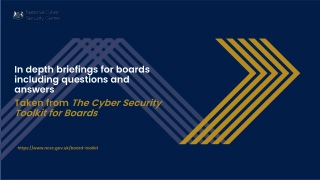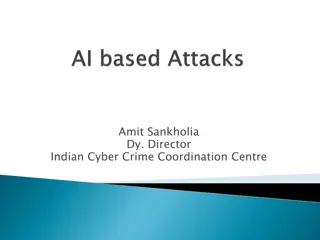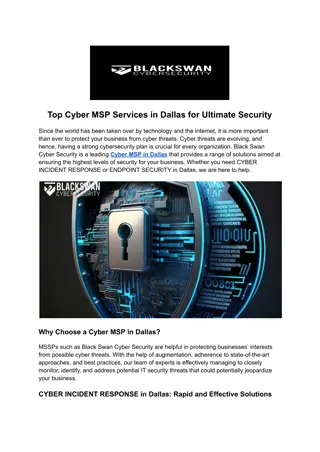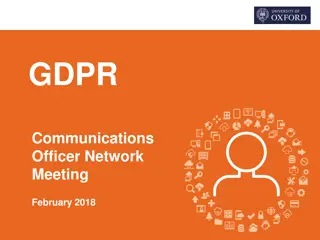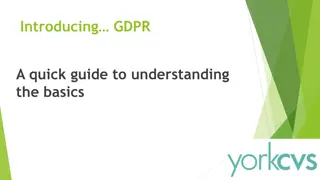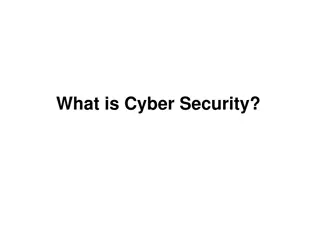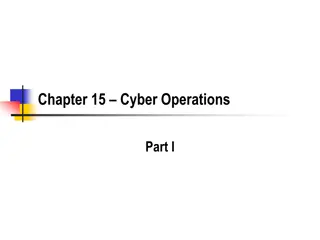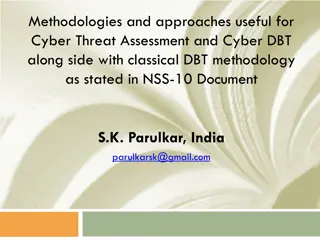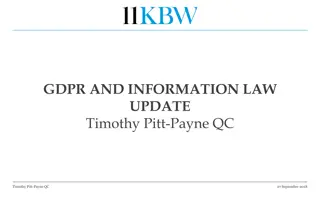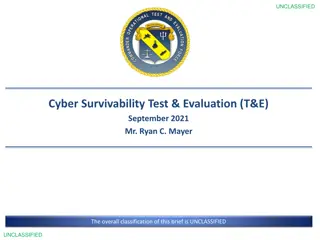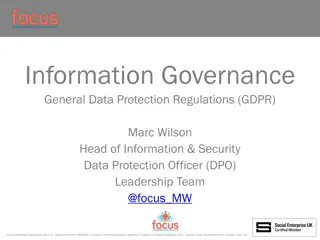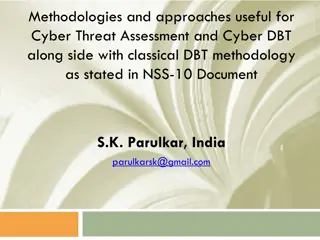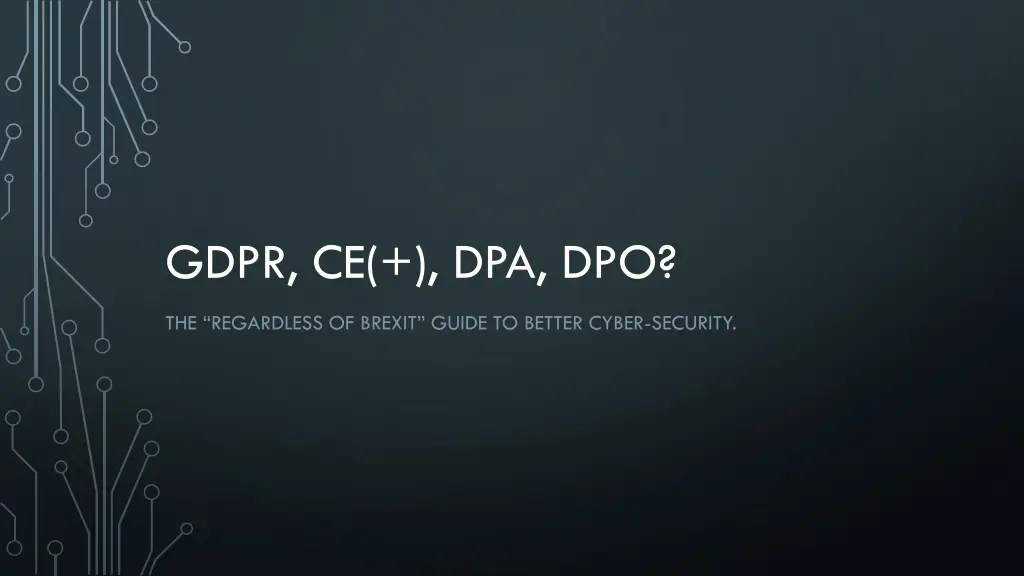
Better Cyber-Security Guide Beyond Brexit
Discover the impact of GDPR, the costs of implementation, and the benefits of prioritizing cyber-security for businesses post-Brexit. Learn from 2nd-year Cyber-Security students and understand the importance of data protection in today's digital landscape.
Download Presentation

Please find below an Image/Link to download the presentation.
The content on the website is provided AS IS for your information and personal use only. It may not be sold, licensed, or shared on other websites without obtaining consent from the author. If you encounter any issues during the download, it is possible that the publisher has removed the file from their server.
You are allowed to download the files provided on this website for personal or commercial use, subject to the condition that they are used lawfully. All files are the property of their respective owners.
The content on the website is provided AS IS for your information and personal use only. It may not be sold, licensed, or shared on other websites without obtaining consent from the author.
E N D
Presentation Transcript
GDPR, CE(+), DPA, DPO? THE REGARDLESS OF BREXIT GUIDE TO BETTER CYBER-SECURITY.
WHO ARE WE? We are 2ndYear Computer and Information Security (Cyber-Security) Students at Sheffield Hallam University Joshua Gregory Victor Cabrera-Colomar Max Alderton Richard Glithero William Costello
THE BIG FIGURE Businesses are liable to fines of up to 20 million or 4% of global revenues, whichever is larger, for breach of GDPR regulations.
COST OF IMPLEMENTATION GDPR preparation has cost FTSE 350 businesses around $1.1 billion According to the International Association of Privacy Professionals and Big Four professional services firm EY, US corporates among the Fortune 500 saw an even higher bill of $7.8 billion companies should be expecting to spend around 300-450 per head on their compliance efforts Consultancy.uk article
NUMBER OF BREACH NOTIFICATIONS TO ICO Number of notifications increased by 4x only two months after GDPR came into effect ICO Personal Data Breach Reporting Webinar July 2018
Work out what data you will need and why. Create the policies needed to protect that data. THE JOURNEY Implement technical measures needed to protect the data. Document processes and procedures for managing data. Scaling and maintaining.
BENEFITS Clearly defines and controls processes of change and expansion in a secure by design method, reducing costs in re-work/re-design. Makes security a working normal, rather than something added, or something that is obstructive. Reduces business and operational risk of data loss, reputational damage, and regulatory fines. Creates standard working practices and can improve performance and reduce cost. Allows for certification, which can open new markets and builds brand confidence.
THE BIGGEST OBSTRUCTION TO PROPER SECURITY IS WHEN IT GETS IN THE WAY. JOSH WISDOM NO.1 IT ONLY GETS IN THE WAY WHEN IT IS NOT BUILT IN AT THE BEGINNING.
A body of information, defined and managed as a single unit, so that it can be understood, shared, protected and exploited effectively. Information assets have recognisable and manageable value, risk, content and lifecycles. SO WHAT IS DATA National Archives
SO WHAT DATA DO YOU NEED? Whether established or just starting, audit your data assets. Ask yourself Do I actually need this information? Could I work in a different way so I don t need this information? Do I have a valid, legal reason for processing this information? How am I processing this data? How long do I need it for? Who is responsible for this data?
LEGAL BASIS? PROCESSING? (DPA2018) Consent The individual has given clear consent for you to process their personal data for a specific purpose. Contract The processing is necessary for a contract you have with the individual, or because they have asked you to take specific steps before entering into a contract. Legal Obligation The processing is necessary for you to comply with the law (not including contractual obligations). Vital Interests The processing is necessary to protect someone s life. Public Task The processing is necessary for you to perform a task in the public interest or for your official functions, and the task or function has a clear basis in law. Legitimate Interests The processing is necessary for your legitimate interests or the legitimate interests of a third party, unless there is a good reason to protect the individual s personal data which overrides those legitimate interests. ico.org.uk
SO WHAT IS A DATA ASSET REGISTER A mechanism for understanding and managing an organisation s assets and the risks to them; including the links between the information assets, their business requirements and technical dependencies National Archives
CREATING A DATA ASSET REGISTER Article 30 Record of Processing Activities international organisations that Retention schedule (if possible) personal data are transferred third countries or international Link to contract with processor security measures (if possible) joint controller (if applicable) transfers of personal data to Categories of personal data Name and contact details of technical and organisational organisations (if applicable) Safeguards for exceptional Names of third countries or Categories of individuals Categories of recipients General description of Purpose of processing to (if applicable) Business function
WHY IS IT IMPORTANT The data asset register Provides a single list of all the data managed by the organisation Is required for certifications Is required for reporting to ICO Makes data management easier Makes risk assessments easier Makes change impacts easier to identify
REMEMBER TO REGULARLY REVIEW AND DOCUMENT THE DATA YOU HOLD. THIS SHOULD BE IN A POLICY
Work out what data you will need and why. Create the policies needed to protect that data. THE JOURNEY Implement technical measures needed to protect the data. Document processes and procedures for managing data. Scaling and maintaining.
A set of policies are principles, rules, and guidelines formulated or adopted by an organization to reach its long- term goals and typically published in a booklet or other form that is widely accessible. POLICIES www.businessdictionary.com
IN SIMPLE TERMS Policies are Documented intentions A set of values Expectations of behaviours A strategic vision The ethical and moral principles of the organisation Policies create consistency and purpose within organisations
A NEW START A new start-up business might only have a small number of policy documents. As businesses expand, policies are created to cover additional requirements and start to refer to each-other for specific guidance. Business Plan Data Protection Policy Change Policy Vision Statement
EXPANDING POLICIES Corporate Plan Data Protection Policy Vision Statement Operational Policies HR Policy Incident Management Policy Staff Training Policy Conduct Management Retention Policy Service Agreements Behavioural Policies Risk Privacy Policy Procurement Change Recruitment Management
IN SIMPLE TERMS! A policy should state the intent, the what you are aiming to achieve. They form the spirit of the activities of your organisation. They are a broad vision, and overview. They help your stakeholders, clients, and staff to understand how your organisation works, and sets expectations on how they will be treated. They make clear, to what values your organisation subscribes.
Work out what data you will need and why. Create the policies needed to protect that data. THE JOURNEY Implement technical measures needed to protect the data. Document processes and procedures for managing data. Scaling and maintaining.
It doesnt matter what policies, and processes you follow, what encryption you have in place to protect your information. TECHNICAL DESIGN & IMPLEMENTATION If your web application has holes a mile wide in it s security then all your secrets are out. Richard Glithero 2019
IF YOU HAVE DONE YOUR WORK RIGHT UP TO THIS POINT, IMPLEMENTING THE SOLUTION SHOULD BE VERY EASY. IF NOT : DISASTER AWAITS : START AGAIN.
WHAT DATA NEEDS TECHNICALLY ENCRYPTION AT REST AND IN TRANSIT BACKUP AND RECOVERY PLAN ACCESS CONTROL AUDITING INTEGRITY VALIDATION PHYSICAL SECURITY
KEEP YOUR EYES OFF MY FILES! File Based Drive Based More Secure Easier to Scale More Complex to Implement Easier to Implement Still an Improvement over no Encryption Only has ONE Encryption Key per Drive
TECHNICAL SECURITY STRATEGIES PERIMETER DEFENCE (Great firewall of failure) DEFENCE IN DEPTH (Onion model) ZERO TRUST (New wisdom)
EXAMPLE DATA SERVER. PERIMETER DEFENCE DEFENCE IN DEPTH ZERO TRUST Data server separate and accessible only from internal (non routable) network. Server needs authentication for any and every request. Data server part of web server and protected only by the server firewall. Protected by firewall but also away from the edge Server uses its own firewall in addition to any other firewalls on the network.
1. Design Solution 2. Review against Policy 3. Identify Problem 4. Modify Design 5. Consult Stakeholders 6. Review Modified Design 7. Specify Requirements 8. Prototype 9. Implement 10. Consult Stakeholders regarding Prototype ACTIVITY CREATE A TECHNICAL IMPLEMENTATION PROCESS. Put the steps in a logical order. ANSWER : 3,5,7,1,2,8,10,4,6,9
Identify Opportunity for Improvement Verify Solution against Aims, and Policies Review Solution Design Solution (Re)Create (Re)Design Implement Solution Specify Solution TECHNICAL IMPLEMENTATION PROCESS With each step, ensuring that all of the deliverable objects are tested against the overall policy of the organisation, which will now include security. Ensuring as best as possible that no costly mistakes are made and possibly ignored.
Work out what data you will need and why. Create the policies needed to protect that data. THE JOURNEY Implement technical measures needed to protect the data. Document processes and procedures for managing data. Scaling and maintaining.
PROCESSES AND PROCEDURES
A process is a set of interrelated or interacting activities which transforms inputs into outputs PROCESS A process is about what we do
A procedure is specified way to carry out an activity or a process PROCEDURE A procedure is about how we do something
Procedure Process Defines the set of steps to achieve the process Defines the Steps to ensure that the policy is enforced/adhered Why is it needed Defines who, when, and how often Step by step, who, what steps and how to deal with problems Level of detail Review frequency As needed After each cycle (Lessons learned)
WHAT MAKES A GOOD PROCEDURE? Effective. Efficient. Relevant. Valid. Usable. Realistic. Managed and Improvable. Measurable.
EXAMPLE Policy GDPR Policy. All personal data will be managed in accordance with legal regulations and best practice guidance. Data Privacy Impact Assessment(DPIA) process. When implementing an information system a Data Privacy Impact Assessment will be done to assess the risks to individual's data and privacy. Process Info/Sec Risk Assessment Procedure Review DPIA with Information Asset Owner Assess Vulnerabilities Assess Threats Perform risk assessment Agree controls to mitigate risks. Agree residual risk Design Solution Procedure
RISK.... ISO 27005 defines Risk as : "The effect of uncertainty on Objectives Processes mitigate risks because they are controls introduced to reduce uncertainty and increase the probability of meeting the desired objectives.
MANAGING... A Key Performance Indicator (KPI) is a measurable value that demonstrates how effective company processes are in achieving key business objectives. Examples include (not limited to): Pen testing Indicators Patching schedules Indicators Sales Indicators Profitability Indicators
EXAMPLE OF DATA PROCESS Create Data Collection Process Data Input Process Use/Share Payroll Process Invoicing Process Archive Backup Process Restore Process Delete Secure Destruction Process Disaster Recovery Process
SECURITY IS NOT AN AFTERTHOUGHT VIC
Work out what data you will need and why. Create the policies needed to protect that data. THE JOURNEY Implement technical measures needed to protect the data. Document processes and procedures for managing data. Scaling and maintaining.
SCALING & MAINTAINING
WHAT IS A CHANGE POLICY? A change policy is a set of policies, processes and procedures which define how a policy change should be implemented.
GOOD CHANGE POLICIES SHOULD CONTAIN Assessment of any risks created as part of the change process and mitigation of these Checks and balances ensuring changes are compatible with business functions and policies Identification of any changes effects on data security and a response to these
A CHANGE PROCESS SHOULD IDENTIFY ANY RISKS CAUSED OR AFFECTED BY THE CHANGES BEING PROPOSED, AND PUT IN PLACE STEPS TO MITIGATE THOSE RISKS. ANY INCLUDES SECURITY!


